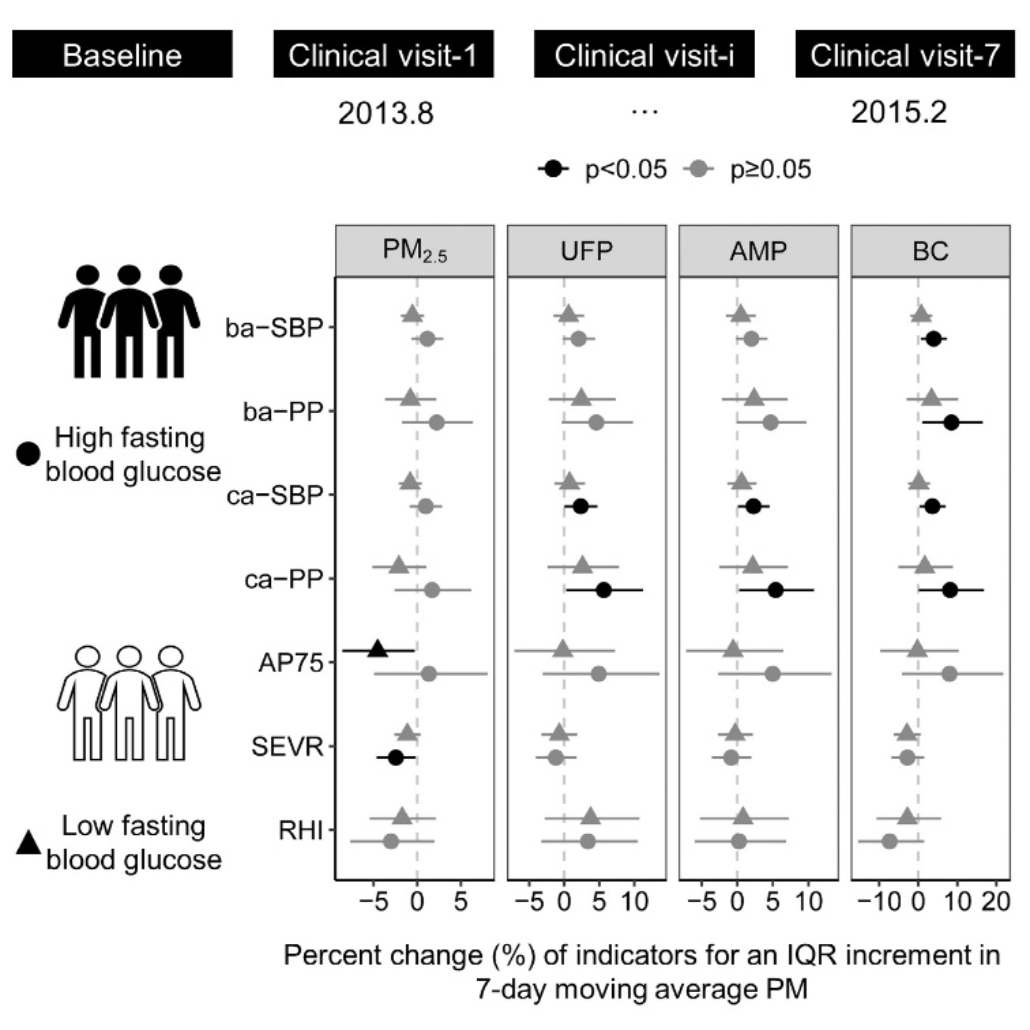在中国近50%的成年人的血糖代谢紊乱,其中10.9%的成年人罹患糖尿病,35.7%的成年人处于糖尿病前期状态。糖尿病和糖尿病前期人群通常面临着多种心血管疾病风险因素的威胁,包括血糖代谢紊乱、血脂代谢紊乱、高血压、肥胖、运动不足等。已有研究表明,这类人群可能对大气颗粒物的不良心血管效应更加易感。血管功能失调是大气颗粒物引发心血管疾病的重要机制之一,但目前对于血糖代谢紊乱人群中大气颗粒物引发的血管功能损伤的认识还十分有限。
亚星游戏网朱彤教授课题组于2013-2015年在亚星游戏网校医院开展前瞻性定组研究SCOPE (A prospective Study COmparing the cardiometabolic and respiratory effects of air Pollution Exposure on healthy and prediabetic individuals),同时对31名糖尿病前期受试者和81名血糖正常的对照受试者进行跟踪随访。通过在北大校园固定站点连续观测的大气颗粒物浓度数据评估受试者的大气污染暴露水平,测量多项血管功能指标(包括外周血压、中心血压、增强压、增强指数、反应性充血指数等)以综合评价受试者的血管功能,采用线性混合效应模型探究了大气颗粒物暴露与血管功能的关联性及血糖代谢状态的修饰作用。
该研究表明,大气颗粒物暴露与血管功能失调相关,具体表现为细颗粒物(PM2.5)、粒径小于100纳米的超细颗粒物(UFP)、粒径在100到560纳米的积聚模态颗粒物(AMP)、黑碳(BC)暴露后,受试者血管弹性降低(脉压升高、射血时间增长、心内膜下心肌的活力率降低),内皮功能失调(反应性充血指数降低)。该研究进一步在血糖水平较高的人群中观察到与大气颗粒物相关的血管功能损伤效应比血糖水平较低的人群更显著,例如,在UFP和AMP暴露后,血糖水平较高的人群中收缩压和脉压显著升高,血糖水平较低的人群则无显著变化。这一研究结果提示血糖代谢紊乱可能加剧大气颗粒物对血管功能的损伤,血糖代谢紊乱人群可能面临更高的由大气颗粒物引发的心血管疾病风险,因此有必要开展更深入的研究来阐明易感性产生的机制,同时采取有效的空气污染控制措施和适当的临床干预手段来保护公众健康。

血糖代谢紊乱加剧大气颗粒物对血管功能的损伤
该研究近日以“Glucose metabolic disorders enhance vascular dysfunction triggered by particulate air pollution: A panel study”为题发表于美国心脏协会心血管著名期刊Hypertension上。亚星游戏网博士后陈悟、韩逸群(现为英国帝国理工学院博士后)为该论文共同第一作者,朱彤教授为通讯作者。该项研究获得国家自然科学基金(21190051、41421064、91844000)和科技部973项目(2015CB553401)的支持,并获得亚星游戏网生物医学伦理委员会的批准(IRB00001052-13024)。
论文信息及链接:Chen W, Han Y, Wang Y, et al. Glucose metabolic disorders enhance vascular dysfunction triggered by particulate air pollution: A panel study. Hypertension, 2022;79(5):1079-1090.https://doi.org/10.1161/HYPERTENSIONAHA.121.18889
SCOPE项目相关文章:
Jiang X, Han Y, Qiu X, et al. Personal exposure to electrophilic compounds of fine particulate matter and the inflammatory response: The role of atmospheric transformation. Journal of Hazardous Materials. 2022;432:128559.https://doi.org/10.1016/j.jhazmat.2022.128559
Lin Y, Zhang H, Han Y, et al. Field evaluation of a potential exposure biomarker of methylated polycyclic aromatic hydrocarbons: Association between urinary phenanthrene-2-carboxylic acid and personal exposure to 2-methylphenanthrene. Environmental Science & Technology Letters. 2022;9(2):166-172.https://doi.org/10.1021/acs.estlett.1c00938
Wang T, Han Y, Li H, et al. Fine particulate matter and vasoactive 20-hydroxyeicosatetraenoic acid: Insights into the mechanisms of the prohypertensive effects of particulate air pollution. Science of The Total Environment. 2022;806(3):151298. https://doi.org/10.1016/j.scitotenv.2021.151298
Shi Y, Han Y, Wang Y, et al. Serum branched-chain amino acids modifies the associations between air pollutants and insulin resistance. Ecotoxicology and Environmental Safety. 2021;225:112780.https://doi.org/ 10.1016/j.ecoenv.2021.112780
Wang T, Han T, Li H, et al. Proinflammatory lipid signals trigger the health effects of air pollution in individuals with prediabetes. Environmental Pollution, 2021;290:118008.https://doi.org/10.1016/j.envpol.2021.118008
Jiang X, Han Y, Qiu X, et al. Organic components of personal PM2.5 exposure associated with inflammation: Evidence from an untargeted exposomic approach. Environmental Science & Technology. 2021;55(15):10589-10596.https://doi.org/10.1021/acs.est.1c02023
Wang T, Han Y, Li H, et al. Changes in bioactive lipid mediators in response to short-term exposure to ambient air particulate matter: A targeted lipidomic analysis of oxylipin signaling pathways. Environmental International, 2021;147:106314. https://doi.org/10.1016/j.envint.2020.106314
Chen W, Han Y, Wang Y, et al. Associations between changes in adipokines and exposure to fine and ultrafine particulate matter in ambient air in Beijing residents with and without pre-diabetes. BMJ Open Diabetes Research and Care, 2020;8:e001215. https://doi.org/10.1136/bmjdrc-2020-001215
Fan Y, Han Y, Liu Y, et al. Biases arising from the use of ambient measurements to represent personal exposure in evaluating inflammatory responses to fine particulate matter: Evidence from a panel study in Beijing, China. Environmental Science & Technology Letters, 2020;7(10):746-752.https://doi.org/10.1021/acs.estlett.0c00478
Chen X, Han Y, Chen W, et al. Respiratory inflammation and short-term ambient air pollution exposures in adult Beijing residents with and without prediabetes: A panel study. Environmental Health Perspectives, 2020;128(6):067004. https://doi.org/10.1289/EHP4906
Zhang H, Han Y, Qiu X, et al. Association of internal exposure to polycyclic aromatic hydrocarbons with inflammation and oxidative stress in prediabetic and healthy individuals. Chemosphere, 2020;253:126748.https://doi.org/10.1016/j.chemosphere.2020.126748
Han Y, Wang Y, Li W, et al. Susceptibility of prediabetes to the health effect of air pollution: a community-based panel study with a nested case-control design. Environmental Health, 2019;18:65. https://doi.org/10.1186/s12940-019-0502-6
Wang Y, Han Y, Zhu T, et al. A prospective study (SCOPE) comparing the cardiometabolic and respiratory effects of air pollution exposure on healthy and pre-diabetic individuals. Science China Life Science, 2018;61:46–56. https://doi.org/10.1007/s11427-017-9074-2
